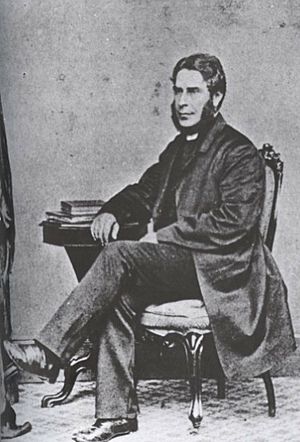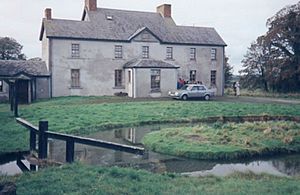Arthur Bell Nicholls facts for kids
Quick facts for kids
Arthur Bell Nicholls
|
|
|---|---|

Portrait of Nicholls in 1854
|
|
| Born | 6 January 1819 Killead, County Antrim, Ireland
|
| Died | 2 December 1906 (aged 87) Banagher, County Offaly, Ireland
|
| Nationality | British |
| Alma mater | Trinity College Dublin (1844) |
| Occupation | Curate |
| Spouse(s) | |
Arthur Bell Nicholls (born January 6, 1819 – died December 2, 1906) was an Irish clergyman. He is best known as the husband of the famous English writer Charlotte Brontë.
From 1845 to 1861, Nicholls worked as an assistant priest for Charlotte's father, Patrick Brontë. He was married to Charlotte for the last nine months of her life. After Charlotte's death, he continued to care for her father. He later moved back to Ireland, got married again, and left his church job.
Contents
Early Life
Arthur Bell Nicholls was one of ten children. He was born in Killead, County Antrim, Ireland. His father, William Nicholls, was a farmer. His mother, Margaret Bell Nicholls, was a member of the Church of Ireland.
He went to school at the Royal Free School in Banagher, County Offaly. His uncle, Alan Bell, was the headmaster there. In 1836, Nicholls started studying at Trinity College Dublin. He finished his studies and graduated in 1844.
Working at Haworth Church
Nicholls became a deacon (a type of church official) in 1845. He started working as an assistant priest for Patrick Brontë in June of that year. Charlotte Brontë thought he seemed like a good young man. She hoped he would do a good job.
He often visited poor people in the area. However, some people thought he was very strict. In 1847, he tried to stop women from hanging their laundry in the church cemetery. Charlotte noticed that many people hoped he would not come back when he was on holiday.
Later, he became closer to Charlotte. By this time, she had written her famous book Jane Eyre. They started writing friendly letters to each other. In December 1848, he led the funeral service for Charlotte's sister, Emily Brontë.
Marriage to Charlotte Brontë
On December 13, 1852, Arthur Nicholls asked Charlotte Brontë to marry him. Charlotte's father, Patrick, was very against the idea. He felt that a poor Irish priest should not marry his famous daughter.
In 1853, Nicholls said he would leave to become a missionary in Australia. But he changed his mind later. He still collected letters of recommendation, even one from Patrick Brontë. He also received a farewell gift from the church members.
He worked in another church for a few months. But he secretly met Charlotte several times in Haworth. Slowly, Charlotte became convinced that she wanted to marry him. In February 1854, her father finally agreed to their visits.
Arthur Nicholls and Charlotte Brontë were married on June 29, 1854. The wedding took place in her father's church in Haworth. Patrick Brontë decided not to attend the wedding that day. So, Charlotte was walked down the aisle by Margaret Wooler, her old school teacher.
They went on their honeymoon in Wales and Ireland. After that, they returned to live with Charlotte's father at Haworth Parsonage.
Charlotte sadly died nine months later, in 1855. Nicholls then became the owner of the rights to her books. This meant he had to protect her memory. He did this until the early 1900s.
Interest in Charlotte's books grew a lot after her death. People wanted to know more about her private life. Her father asked Charlotte's friend, the writer Elizabeth Gaskell, to write an official book about Charlotte. This book would correct any wrong information.
Arthur Nicholls was not sure about helping at first. He would have to let Gaskell use Charlotte's personal letters. But he eventually agreed. After Gaskell's book, The Life of Charlotte Brontë, came out in 1857, Nicholls got involved in arguments about it. He wrote angry letters to newspapers to defend how Gaskell described Charlotte's sad school days.
Nicholls stayed at Haworth Parsonage as Patrick's assistant. He lived there until Patrick's death in June 1861. People expected him to take over as the main minister. However, the church leaders voted against him, and he resigned. In October 1861, he sold the items from Haworth Parsonage in an auction. He kept the family's writings and personal things. He also gave gifts to the family's servants. Then, he moved back to Ireland.
How People Saw Their Marriage
Some of Charlotte's friends had different opinions about Arthur Nicholls. Ellen Nussey, a friend of Charlotte's, blamed Nicholls for Charlotte's death. Another friend, Mary Taylor, disagreed with Ellen. She felt Ellen had pressured Charlotte about her choice.
Elizabeth Gaskell thought Nicholls was stubborn. But she also said that Charlotte "would never have been happy but with an exacting, rigid, law-giving, passionate man." The two servants at the parsonage, Tabitha Aykroyd and Martha Brown, believed that Charlotte and Arthur were happy together.
Charlotte herself wrote during her honeymoon that marriage was "a strange and solemn and perilous thing for a woman." However, later she wrote that Arthur "is certainly my dear boy, and he is dearer to me today than he was six months ago."
Return to Ireland
After Charlotte and Patrick Brontë died, Nicholls went back to Banagher in County Offaly. He lived with his aunt, who was a widow, and her daughter, Mary Anna Bell. He married Mary Anna in 1864.
He stopped working as a priest and managed a small farm. He often refused to help people who wanted to write books about the Brontës. By then, the Brontë sisters were very famous writers.
He spoke out briefly in 1876. This was to protest parts of a book about Charlotte by T.W. Reid. The book used Charlotte's writings without his permission. Later, in 1895, he agreed to let Clement Shorter see his Brontë collection. Shorter was a journalist. He had already convinced Ellen Nussey to sell her letters to protect them. Shorter then convinced Nicholls to do the same. Within a year, Shorter started selling Nicholls's collection of Brontë letters at auctions.
Arthur Bell Nicholls died in December 1906 from a lung illness called bronchitis.
His wife sold the Brontë items he had inherited in auctions in 1907, 1914, and 1916. These items included Brontë writings, personal belongings, furniture, and artwork. Arthur had brought these from Haworth in 1861. Many important portraits of the Brontës that were thought to be lost were found this way. These included a painting of the three sisters by Branwell Brontë. Most of this collection has since been returned to Haworth Parsonage, which is now the Brontë family museum.
See Also



